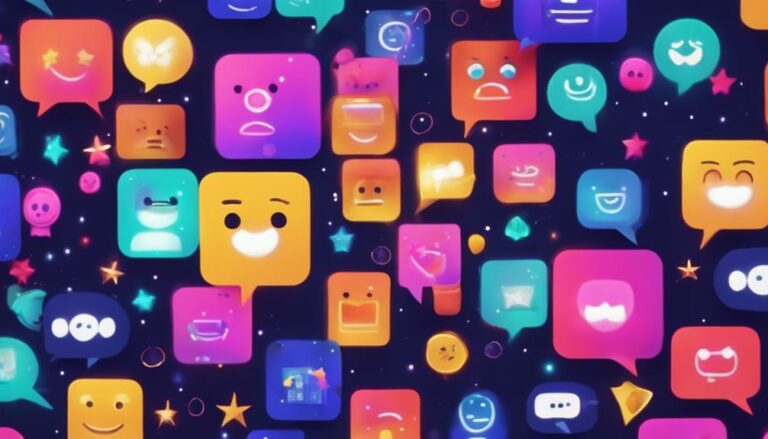I've found that to excel in chatbot marketing, I need to set clear objectives tailored to my brand strategy. Understanding my audience is vital, so I analyze their behavior and tailor personalized interactions to build lasting loyalty. Maintaining a consistent brand voice across platforms is key to fostering trust. Continuous optimization through A/B testing and machine learning keeps my chatbot effective. Integrating chatbots seamlessly into my marketing ecosystem enhances support and boosts lead generation. Strategic use of personalized product recommendations and timely promotional messages drives conversions and increases sales. Stick around to explore these strategies in more detail.
Key Takeaways
- Define clear chatbot marketing goals aligned with your brand strategy to enhance user engagement and conversion rates.
- Understand your target audience through data analysis and tailor chatbot interactions to build lasting brand loyalty.
- Maintain a consistent brand voice across all chatbot interactions to establish trust and reinforce brand identity.
- Continuously optimize chatbot performance using A/B testing and machine learning algorithms for improved user engagement.
- Utilize chatbots for 24/7 customer support to decrease support costs and improve customer satisfaction with instant responses.
Define Clear Objectives
Defining clear objectives in chatbot marketing is essential for ensuring that each interaction aligns with the overall brand strategy and meets specific business goals. By setting precise chatbot marketing goals such as lead generation, customer support, or sales funnel optimization, I can guide the chatbot's development effectively.
This clarity enables targeted messaging, personalized experiences, and efficient user engagement, ensuring that the chatbot meets customer needs while driving results. Additionally, clear objectives help in measuring success, optimizing performance, and refining strategies.
Aligning chatbot functions with brand strategy not only enhances user engagement but also facilitates seamless integration into the marketing ecosystem, ultimately boosting lead generation and sales funnel efficiency.
Know Your Audience
Understanding your audience starts with identifying target demographics and analyzing user behavior.
By leveraging data and user sentiment analysis, I can tailor chatbot interactions to meet specific customer needs.
Customizing responses based on these insights not only enhances engagement but also builds lasting brand loyalty.
Identify Target Demographics
To effectively utilize chatbot marketing, brands need to precisely analyze their target demographics by leveraging data on age, location, interests, and behavior. By using tools like Google Analytics, social media insights, and customer surveys, I can gather detailed demographic information. This data allows me to tailor content and tone to resonate with my audience's preferences.
Conducting A/B testing further refines my strategy by observing how different demographics respond. I segment my audience to personalize user experiences, delivering relevant content that appeals to distinct groups. Analyzing this data helps me guarantee my chatbot marketing efforts are both strategic and impactful, fostering deeper connections with my audience through innovative and targeted interactions.
Understand User Behavior
Analyzing consumer data reveals that 73% of users prefer personalized messaging, so I prioritize researching user preferences and behaviors to enhance chatbot interactions.
By conducting rigorous data analysis, I identify patterns and trends in user interactions, ensuring that the chatbot provides relevant responses.
Implementing smart intent recognition helps me anticipate user needs, aligning with the 80% of consumers who favor personalized experiences.
I also leverage sentiment analysis to gauge user sentiment and tailor responses accordingly. This strategic focus on user sentiment ensures that 91% of consumers receive relevant recommendations.
Continuously optimizing based on user feedback, I cater to user needs effectively, reducing the 74% frustration rate from non-personalized content.
This data-driven approach positions the brand for innovative success.
Personalize Interactions

Brands can greatly enhance customer engagement and conversion rates by personalizing chatbot interactions based on user preferences. Data shows that personalized interactions increase customer engagement by 3 to 4 times, leading to higher conversion rates.
Here's how brands can leverage chatbots to create personalized experiences:
- Analyze User Preferences: Tailoring responses to user preferences can boost customer satisfaction by 20%.
- Implement Personalization Strategies: Brands that personalize interactions see a 10% increase in revenue and a 15% decrease in customer churn rates.
- Engage Effectively: 74% of customers are more likely to engage with brands offering personalized experiences through chatbots.
Maintain Brand Voice
Maintaining a consistent tone across platforms is essential for brand recognition and trust.
I'll focus on aligning chatbot responses with our brand's personality and values, which has been shown to boost customer engagement and satisfaction.
Studies indicate that brands who do this effectively see higher conversion rates and retention.
Consistent Tone Across Platforms
Achieving a consistent brand voice across all platforms is essential, as 60% of consumers expect uniform experiences from brands. Maintaining this consistency aids in establishing trust and reinforcing brand identity.
To guarantee a reliable and authentic brand presence, I focus on three key areas:
- Tone: Adopt a consistent tone that reflects our brand's personality in every interaction.
- Messaging: Align messaging across all channels to create a seamless customer experience.
- Customer Experience: Foster long-term relationships by providing a cohesive and reliable experience.
Personalized Messaging Strategies
To further enhance the customer experience, personalized messaging strategies allow us to uphold our brand voice while greatly boosting engagement and satisfaction rates. Personalized messages create a memorable experience, driving up customer engagement by up to 80%. By guaranteeing brand consistency, we build trust and loyalty, leading to higher conversion rates and increased customer retention. Here's how:
| Strategy | Benefit |
|---|---|
| Maintain Unique Voice | Memorable Experience |
| Personalize Customer Interactions | Increased Engagement |
| Guarantee Brand Consistency | Higher Conversion Rates |
| Build Trust and Loyalty | Increased Customer Retention |
Optimize Continuously

Optimizing your chatbot continuously based on user feedback and interaction data is crucial for maintaining high engagement and satisfaction rates. By leveraging this approach, I can guarantee that my chatbot remains effective and relevant.
Here's a strategic plan:
- A/B Testing: Regularly implement A/B testing to refine conversational flow, enhancing both engagement and conversion rates.
- Machine Learning Algorithms: Use machine learning algorithms to improve the chatbot's ability to understand and respond accurately, boosting user satisfaction.
- Knowledge Base Updates: Regularly update the knowledge base with the latest information to provide accurate responses.
Leverage Data Insights
Building on continuous optimization, leveraging data insights allows me to personalize chatbot interactions based on real customer preferences and behavior patterns. By analyzing collected data, I can optimize performance and drive engagement through targeted messaging. This strategy enables me to tailor marketing messages, recommend products, and offer relevant solutions in real-time, meeting customers' immediate needs.
Data insights empower me to understand customer behavior better, leading to increased conversion rates and enhanced user experiences. The ability to deliver real-time solutions not only boosts brand loyalty but also refines my chatbot strategies continuously.
Seamless Integration

Seamless integration of chatbots across platforms like websites, social media, and messaging apps greatly enhances user experience by providing consistent support and engagement at every touchpoint. By employing cross-channel integration, brands can effectively gather data and personalize interactions, guaranteeing a cohesive customer experience.
Here's how:
- Consistent Support: Users receive the same level of assistance across all platforms, eliminating frustration and improving satisfaction.
- Enhanced Engagement: Integrated chatbots keep customers engaged by providing relevant and timely responses, boosting overall interaction quality.
- Data Collection: Seamless integration allows for thorough data collection, enabling personalized experiences and informed decision-making.
Incorporating these strategies ensures that customers enjoy a unified, efficient, and engaging journey, cementing the brand's reputation for innovation and reliability.
Enhance Customer Support
Utilizing chatbots for 24/7 customer support drastically reduces response times and heightens customer satisfaction. By handling up to 80% of routine inquiries, chatbots free up human agents for complex issues, thereby improving customer support.
Studies show that 64% of consumers prefer chatbots for their instant responses and availability. This approach not only decreases support costs by up to 30% but also enhances customer engagement through personalized interactions and tailored recommendations.
Boost Lead Generation

Implementing chatbots can increase lead generation by up to 67%, making them a strategic asset for businesses looking to boost revenue growth. By automating responses, chatbots capture leads promptly and efficiently.
Here's how chatbots can enhance lead generation:
- Personalized Interactions: Engage users with tailored messages based on their behavior, increasing lead quality.
- Data Collection and Segmentation: Gather and analyze user data to segment traffic effectively, directing targeted advertisements to potential leads.
- Efficiency: Save time and save money by automating repetitive tasks and focusing on high-value interactions.
Increase Sales Conversions
By implementing chatbots, I can increase conversions by up to 67% through personalized product recommendations and timely promotional messages.
These chatbots streamline the ordering process and guide users effectively through the sales funnel.
Additionally, they save time and money by automatically handling common sales-related inquiries.
Personalized Product Recommendations
Personalized product recommendations can greatly enhance sales conversions, with data showing a potential increase of up to 26%. By leveraging customer data, I can offer tailored suggestions that notably boost average order value by 68%.
Utilizing AI-powered chatbots, I can implement dynamic product suggestions based on real-time browsing behavior, leading to a 33% rise in repeat purchases.
Here's a strategic approach:
- Analyze customer data to understand preferences and behaviors.
- Deploy AI-powered chatbots to provide real-time, personalized product recommendations.
- Monitor and adjust dynamic product suggestions to optimize conversion rates.
With these steps, I can drive a 70% increase in customer engagement and a 42% higher conversion rate, positioning my brand as an innovator in personalized marketing.
Timely Promotional Messages
Sending timely promotional messages through chatbots can boost sales conversions by as much as 40%. Leveraging chatbots to deliver these targeted promotional messages at the right moment leads to a 300% increase in click-through rates.
By reaching customers instantly, we achieve a 10x higher engagement rate compared to traditional email marketing. This real-time interaction results in a 25% higher conversion rate and a 20% increase in average order value for brands.
Chatbots enable us to strategically engage with our audience, ensuring that promotional messages aren't just timely but also relevant. Brands looking to innovate and enhance their marketing efforts must harness the power of chatbots for delivering timely promotional messages, driving significant increases in sales conversions and customer engagement.
Frequently Asked Questions
What Is One Tip for Using Chatbots in a Marketing Strategy?
To boost user engagement, I'd use chatbots for personalized messaging and instant responses. They'd streamline data collection and lead generation, provide automated follow-ups, offer customer support, and deliver interactive experiences with conversational ads, enhancing behavioral insights.
How to Use Chatbots for Marketing?
To use chatbots for marketing, I juxtapose customer support with event promotion, leveraging user segmentation, personalized messaging, and lead generation. Chatbots excel in content distribution, product recommendations, loyalty programs, survey distribution, and social media engagement.
What Are the 7 Steps to Create a Chatbot Strategy?
To create a chatbot strategy, I start with customer segmentation and develop user personas. I focus on message personalization, build a robust content strategy, use data analytics for insights, optimize conversions, enhance user engagement, define brand voice, train the chatbot, and perform A/B testing.
How Are Brands Using Chatbots?
Brands are using chatbots for personalized messaging, customer support, lead generation, and user engagement. They utilize interactive quizzes, product recommendations, event promotion, feedback collection, and content distribution on social media to enhance customer experiences and drive innovation.
Conclusion
To sum it up, effective chatbot marketing is like a well-oiled machine—it requires clear objectives, audience knowledge, and constant optimization.
By seamlessly integrating chatbots, personalizing interactions, and maintaining your brand's voice, you'll not only enhance customer support but also boost lead generation and sales conversions.
Remember, the key is to keep refining your strategy. Data shows that a fine-tuned chatbot can be a game-changer for your brand's success.






